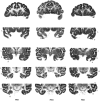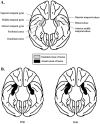Perirhinal cortex ablation impairs visual object identification
- PMID: 9482811
- PMCID: PMC6792933
- DOI: 10.1523/JNEUROSCI.18-06-02268.1998
Perirhinal cortex ablation impairs visual object identification
Abstract
Impairments in both recognition memory and concurrent discrimination learning have been shown to follow perirhinal cortex ablation in the monkey. The pattern of these impairments is consistent with the hypothesis that the perirhinal cortex has a role in the visual identification of objects. In this study we compared the performance of a group of three cynomolgus monkeys with bilateral perirhinal cortex ablation with that of a group of three normal controls in two tasks designed to test this hypothesis more directly. In experiment 1 the subjects relearned a set of 40 familiar concurrent discrimination problems; the stimuli in each trial were digitized images of real objects presented in one of three different views. After attaining criterion they were tested on the same problems using similar, but previously unseen, views of the objects. In experiment 2 the subjects were tested on their ability to perform 10 of these familiar discriminations with each problem presented in the unfamiliar context of a digitized image of a unique complex scene. The subjects with ablations were significantly impaired on both tasks. These results demonstrate that the role of the perirhinal cortex is not restricted to memory, and they support the hypothesis that the perirhinal cortex is involved in visual object identification. We suggest that the perirhinal cortex is crucially involved in processing coherent concepts of individual objects. A deficit of this nature could underlie the pattern of impairments that follow perirhinal cortex damage in both visual object recognition memory and visual associative memory.
Figures






References
-
- Buckley MJ, Gaffan D. Impairment of visual object discrimination learning after perirhinal cortex ablation. Behav Neurosci. 1997;111:467–475. - PubMed
-
- Buckley MJ, Gaffan D. Learning and transfer of object-reward associations and the role of the perirhinal cortex. Behav Neurosci. 1998a;112:1–9. - PubMed
-
- Buckley MJ, Gaffan D (1998b) Perirhinal cortex ablation impairs configural learning and paired-associate learning equally. Neuropsychologia, in press. - PubMed
-
- Buckley MJ, Gaffan D, Murray EA. A functional double dissociation between two inferior temporal cortical areas: perirhinal cortex vs. middle temporal gyrus. J Neurophysiol. 1997;77:587–598. - PubMed
-
- Eacott MJ, Gaffan D, Murray EA. Preserved recognition memory for small sets, and impaired stimulus identification for large sets following rhinal cortex ablation in monkeys. Eur J Neurosci. 1994;6:1466–1478. - PubMed
Publication types
MeSH terms
LinkOut - more resources
Full Text Sources
